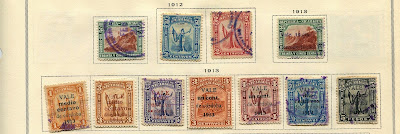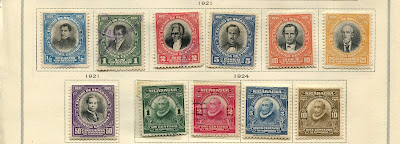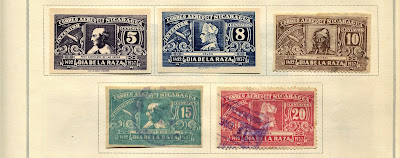This excess, however, is not without attractiveness
and historical interest. Take, for instance, the frequent appearance of the
liberty cap, el gorro frigio, sometimes hoisted on a pike atop a
mountain and sometimes floating mid-air.
The roughly conical cap with a floppy top originated
in ancient Phrygia. It was adopted during 18th century American revolution as a
symbol for freedom from colonial oppression, although the ancient cap had
nothing to do with freedom. Nevertheless, Nicaragua follow suit.
On stamps, the cap hovers over the five volcanic
mountains that represent the five Central American countries -- Costa Rica, El
Salvador, Guatemala, Honduras, and Nicaragua. Usually the cap is very small, as
on Scott #o128, and easily mistaken for a crucifix or overlooked altogether.
Beyond the USA and Nicaragua, many countries in Central and South America have adorned stamps and coins with Phrygian caps, including Mexico and Argentina.
A particularly
interesting and treacherous area of Nicaraguan philately is the local stamps of
Cabo Gracias a Dios and Bluefields. These are mostly regular Nicaragua stamps
overprinted for use in the eastern part of the country where currency was
denominated in silver; they’re treacherous because the double and sometimes
triple overprints are expensive and easily faked (Scott’s catalog says so).
Cabo Gracias a Dios is
thought to have been named by Christopher Columbus in 1502 in thanksgiving for
deliverance from rough seas, perhaps a hurricane. The above scan shows four
hand-stamped Cabo overprints, the most impressive being the yellow one peso
with a clear Cabo cancellation. Sadly, Scott doesn’t list it as a legitimate
stamp. So, I tend to regard it as a fancy flimflam. But then, there are hundreds
of unlisted and unauthorized hand-stamped surcharges.
Bluefields, located south of Cabo on the Atlantic coast, derives its name from Abraham Blauvelt, a Dutch pirate in the early 17th century. The stamps commonly have two overprints, a capital “B” for Bluefields and “Dpto Zelaya” for the Province of Zelaya, the latter overprint being the smaller. Inking and clarity vary greatly.
Hence the double irony of
Scott #s 1L109-1L123: locomotives are featured on the one series of stamps
issued specifically for purchase with the silver coins of eastern Nicaragua, a
place without trains. Moreover, in 1912, the year after this series was issued,
Ferrocarril de Nicaragua changed its name to Ferrocarril del Pacifico de
Nicaragua. A gesture of honesty, I suppose. The last effort to extend rail
service to the Atlantic succumbed in 1909, never to be revived.
The philatelic locomotive
is generic, not a likeness of Nicaraguan rolling stock. Produced by Waterlow
and Sons of London, this series must have been printed in excessive numbers
for, within a matter of months, they were overprinted for use in the
silver-bereft western part of Nicaragua. Regardless, the series has become
popular with collectors.
Recently, appreciation of
Nicaragua’s stamps has grown, in large part, because of the pioneering work of
the Nicaragua Study Group, NICARAO, and their website http://www.bio-nica.info/NICARAO/00-NICARAO.htm.
Beginning specialists and even worldwide collectors will find their work
helpful. For a discussion of Seebeck’s impact on Nicaraguan philately, see https://www.linns.com/news/postal-updates-page/seebeck-made-many-cheap-stamps-for-collectors.html.
Census: 568 in BB spaces,
28 tip-ins, 603 on supplement pages.


















































































































Very interesting and comprehensive posting for these issues!
ReplyDeleteThanks.
ReplyDeleteBud, another great post, and thanks so much for doing this for us. At the same time, I'm still convinced after seeing pages for Nicaragua (and when you posted Colombia) that it's such a shame that Scott didn't include the Colombia States and Zelaya/Cabo for Nicaragua. It makes my '47 more difficult to complete but I can't imagine collecting these countries without the States. Thanks again! Ray
ReplyDeleteYes, Scott should have consulted collectors more widely before chopping out Colombian and Nicaraguan states. I've thought of buying those pages from a '47 compyright album and inserting them in my '69 album, but haven't done it yet.
ReplyDeleteThe pages that come with the various editions sometimes differ even when the date is the same. Not all '47 editions are alike, and the same is true for all other BB albums, I've found.